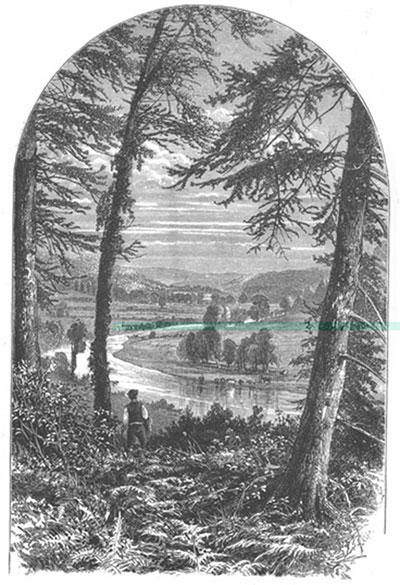The Vale of Avoca, County Wicklow - Irish Pictures (1888)
From Irish Pictures Drawn with Pen and Pencil (1888) by Richard Lovett
Chapter II: The Garden of Ireland … continued
« Previous Page | Start of Chapter | Book Contents | Next Page »
The road from the Devil's Glen through Rathnew to Wicklow has many pleasant spots, though at neither place is there anything of special interest. The 'Garden of Ireland' extends further to the south and west, and below Rathdrum is situated its most celebrated district, the Vale of Avoca or Ovoca, since it seems to answer to both names. This is a lovely valley through which the Avonmore flows, until it meets and mingles its waters with the Avonbeg. The spot where the union takes place is known as the Meeting of the Waters, and it is difficult to conceive of lovelier scenery.
On a sunny summer's day the visitor feels that the United Kingdom cannot show a fairer scene. Still even here man has done what he can to mar the beauty. The railway—a necessary evil—runs through it; yet as it is only a single line and trains are not frequent, this is not such a drawback as it might be. But between Rathdrum and Gorey great beds of copper-pyrites exist, and were recently being worked, and the result, while probably satisfactory from the commercial point of view, has been disastrous to the picturesque effect. The great heaps of reddish-brown refuse seem sadly out of place. The associations and evidences of mining come upon one as a painful contrast, when suddenly encountered in the midst of so much pure loveliness. Doubtless some of the popularity of this region is due to Moore's verses; but then his lines do fairly represent the impression produced upon a sympathetic observer by the quiet beauty of these peaceful scenes. Allowing something for Celtic imagination, the description even yet holds good:
'There is not in this wide world a valley so sweet
As the vale in whose bosom the bright waters meet;
Oh! the last rays of feeling and life must depart
Ere the bloom of that valley shall fade from my heart.
Yet, it was not that Nature had shed o'er the scene
Her purest of crystal, and brightest of green;
'Twas not the soft magic of streamlet or hill,
Oh, no! it was something more exquisite still.
'Twas that friends, the beloved of my bosom, were near,
Who made each dear scene of enchantment more dear;
And who felt how the best charms of Nature improve
When we see them reflected from looks that we love.
Sweet Vale of Avoca! how calm could I rest
In thy bosom of shade with the friends I love best,
Where the storms that we feel in this cold world should cease,
And our hearts, like thy waters, be mingled in peace.'
A few miles south-west of Wooden Bridge Station is the wood of Shillelagh, famous as having given the name to that weapon with which so many Irish heads have been broken in past days. But as long ago as 1693 the greater part of the wood was cut down for use in the furnaces of the ironworks of that period. Westminster Hall is said to have been roofed with oak cut from the woods of Shillelagh.
« Previous Page | Start of Chapter | Book Contents | Next Page »

